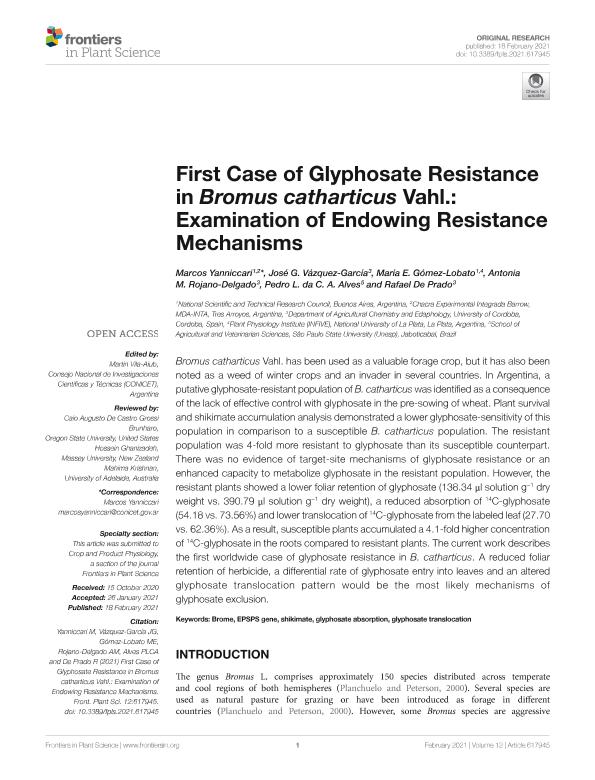Artículo
First Case of Glyphosate Resistance in Bromus catharticus Vahl.: Examination of Endowing Resistance Mechanisms
Yanniccari, Marcos Ezequiel ; Vázquez García, José G.; Gómez Lobato, María Eugenia
; Vázquez García, José G.; Gómez Lobato, María Eugenia ; Rojano Delgado, Antonia María; da C. A. Alves, Pedro L.; De Prado, Rafael
; Rojano Delgado, Antonia María; da C. A. Alves, Pedro L.; De Prado, Rafael
 ; Vázquez García, José G.; Gómez Lobato, María Eugenia
; Vázquez García, José G.; Gómez Lobato, María Eugenia ; Rojano Delgado, Antonia María; da C. A. Alves, Pedro L.; De Prado, Rafael
; Rojano Delgado, Antonia María; da C. A. Alves, Pedro L.; De Prado, Rafael
Fecha de publicación:
02/2021
Editorial:
Frontiers Media
Revista:
Frontiers in Plant Science
ISSN:
1664-462X
Idioma:
Inglés
Tipo de recurso:
Artículo publicado
Clasificación temática:
Resumen
Bromus catharticus Vahl. has been used as a valuable forage crop, but it has also been noted as a weed of winter crops and an invader in several countries. In Argentina, a putative glyphosate-resistant population of B. catharticus was identified as a consequence of the lack of effective control with glyphosate in the pre-sowing of wheat. Plant survival and shikimate accumulation analysis demonstrated a lower glyphosate-sensitivity of this population in comparison to a susceptible B. catharticus population. The resistant population was 4-fold more resistant to glyphosate than its susceptible counterpart. There was no evidence of target-site mechanisms of glyphosate resistance or an enhanced capacity to metabolize glyphosate in the resistant population. However, the resistant plants showed a lower foliar retention of glyphosate (138.34 μl solution g−1 dry weight vs. 390.79 μl solution g−1 dry weight), a reduced absorption of 14C-glyphosate (54.18 vs. 73.56%) and lower translocation of 14C-glyphosate from the labeled leaf (27.70 vs. 62.36%). As a result, susceptible plants accumulated a 4.1-fold higher concentration of 14C-glyphosate in the roots compared to resistant plants. The current work describes the first worldwide case of glyphosate resistance in B. catharticus. A reduced foliar retention of herbicide, a differential rate of glyphosate entry into leaves and an altered glyphosate translocation pattern would be the most likely mechanisms of glyphosate exclusion.
Palabras clave:
BROME
,
EPSPS GENE
,
GLYPHOSATE ABSORPTION
,
GLYPHOSATE TRANSLOCATION
,
SHIKIMATE
Archivos asociados
Licencia
Identificadores
Colecciones
Articulos(INFIVE)
Articulos de INST.DE FISIOLOGIA VEGETAL
Articulos de INST.DE FISIOLOGIA VEGETAL
Articulos(SEDE CENTRAL)
Articulos de SEDE CENTRAL
Articulos de SEDE CENTRAL
Citación
Yanniccari, Marcos Ezequiel; Vázquez García, José G.; Gómez Lobato, María Eugenia; Rojano Delgado, Antonia María; da C. A. Alves, Pedro L.; et al.; First Case of Glyphosate Resistance in Bromus catharticus Vahl.: Examination of Endowing Resistance Mechanisms; Frontiers Media; Frontiers in Plant Science; 12; 2-2021; 1-10
Compartir
Altmétricas



